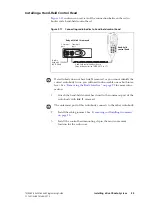
44
Programming a Dual-Radio System
TM8260 Installation and Programming Guide
© Tait Limited
October 2014
System Timing
For the cross-band repeater to operate correctly with other base stations or
repeaters, system timing must be taken into account. If using subaudible
signalling and the transmitter requires a “tail”, then this can be configured
according to
. During the lead-out delay period, no signalling,
such as CTCSS or DCS, is present.
4.5
Upgrading Radio Firmware
The Tait Firmware Upgrade Tool (from the programming application, click
Tools >
Download
) shows the NTID (network ID) for each device. When
reporting a radio system’s configuration, the table will list the various types
of firmware for all devices in the system.
Notice
Reporting the configuration will also show SCT (System
Configuration Table) files for each device, which must exist for a radio
system. These files are the result of downloading configurations (see
“Downloading Configurations” on page 17
). Do not attempt to delete
these files.
When you download firmware to hardware of a particular type (for example,
the target hardware shows as a radio body), it will be sent to all devices in
the system of the same hardware type. The firmware will be downloaded to
each device in sequence.
For more information, access the Help of the Tait Firmware Upgrade Tool
(Help menu).
4.6
Calibrating a Dual-Radio System
TM8260 dual radio systems do not support calibration of the radio system
as a whole. The system must first be disassembled to a single head / single
body configuration. If calibration is required after repair, the radio body
must be calibrated outside of the system before re-installation.
To disassemble the radio to a single head and body, see
and
Table 4.5
Transmit tail in the Basic Settings form, Subaudible Signalling tab
Field
Setting
CTCSS Settings
Lead-Out Delay
any duration, up to 1000ms
DCS Settings
Lead-Out Delay
any duration, up to 1000ms























